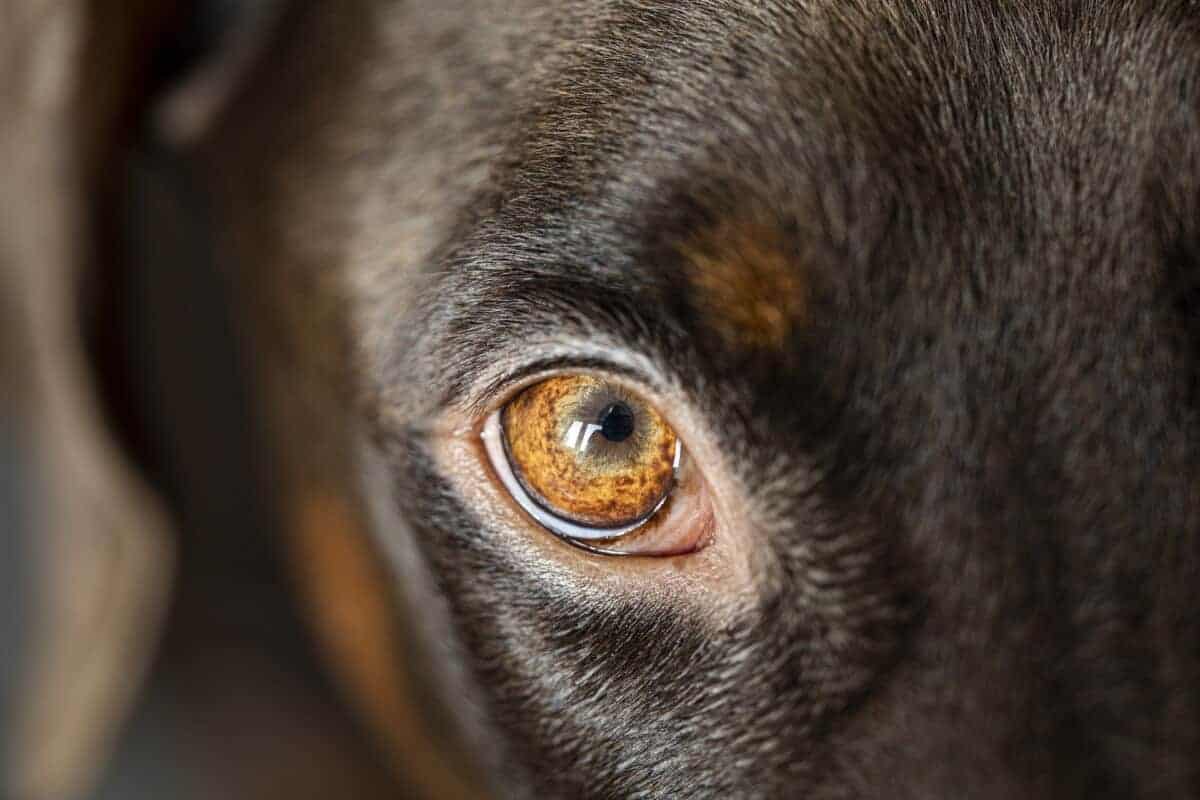It’s not uncommon for people to be afraid of the dark, so it’s not a stretch to think dogs might be afraid of the dark, too. Does your dog act anxious or whine more when the sun’s down, especially on walks? You may be wondering if he or she is afraid of the dark.
Dogs are not usually afraid of the dark and can actually see better than humans in the dark so long as they don’t have vision issues. If a dog is afraid of the dark, it’s due to an anxiety issue that should be addressed.
If your dog is whining or anxious after the sun goes down, it’s more likely a sign of something else. Here are some possibilities to what your dog may be reacting to.
Contents
How to Tell If Your Dog Is Afraid of the Dark
First and foremost, it’s important to identify the signs of anxiety in dogs. While some behavior may be an attempt to gain your attention or for a treat, anxiety in dogs is very different from either of those.
Signs of anxiety in dogs may include:
- Whining or whimpering
- Pacing restlessly
- Drooling
- Barking
- Panting
- Accidents
Alternatively, if you’re crate training or leave your dog in a dark room while you’re in another, it’s very likely your dog may be suffering from separation anxiety as opposed to being afraid of the dark. Try comforting your dog to see if this relieves the symptoms listed above.
Does a Full Moon Affect Dogs
If you have ever walked your dog during the night, you will know it’s common to see them become very alert and aware of all their surroundings. Whether this is talking from nearby houses, or rustling in the bushes you do is going to be taking it all in.
As an added factor walking your dog during a full moon can also bring about some wary behaviors. A high number of dog owners would express that their pooch acts a bit differently than usual, however, it is important to realize that any connection between your dog and a full moon has never been proven.
Speaking from experience, walking your dog during a full moon does make them become more agitated and alert. The most likely cause of your dog’s erratic behavior during this time is the effect of shadows during the walk. My dog has always acted cautiously towards any reflective items in the road or on the pavement, whether this is a traffic cone or a cyclist with a small torch.
The moon will create shadows that emerge uncharacteristically from the darkness, this can spook your dog and make them more aware of their surroundings during the walk. Anything such as rustling bushes or distance talking will most likely also freak your dog out and have them on high alert for the rest of the walk.
If you want to learn more about walking your dog at night, check out our guide on “How To Walk Your Dog At Night”.

Do Dogs Have Night Vision?
While your dog may not be a superhero (or maybe he or she is!), dogs have adapted to see better in the dark than us humans. In fact, while humans see best in bright light, dogs can see just as fine in bright light or dark light. There are a few reasons for this.
Dogs Have a Larger Pupil
As most of us have realized as we have got older, our pupils will dilate in order to let more light in. This allows us to see better in the dark as your eye is able to use a very limited amount of light to see. Although humans do not have the best eyesight in the dark, dogs can see very well. Dogs have much quicker and larger pupil dilation than humans, which allows them to see better in dark situations such as at night.
Dogs’ Eye Anatomy Evolved to See in the Dark
A dog’s eye anatomy has many advantages over a human eye when it comes to being able to see at night. Scientists have identified these anatomical differences as:
More Light-Sensitive Cells (or Rods): Rods are an important cog in the operation of the eye and are designed to operate in low-light situations. Cones are responsible for controlling colors and generally operate in lighter conditions. Dogs have more efficient rods than cones, this allows them to see better in the dark.
Retinal Differences: Two factors in the retina lead to better vision in the dark for dogs. The first is light-sensitive compounds naturally respond better to low light, and the lens of the eye is closer to the retina itself. Both of these items combine to cause the image projected on the retina to appear brighter, therefore giving the brain a better picture of what’s ahead.
Dogs Have an Extra Tool for Night Vision: The Tapetum
While larger pupils and evolved eye anatomy both already cause vision advancement in dogs, they also have a feature nonexistent in humans called the tapetum. According to Britannica the tapetum essentially acts as a type of mirror in the back of the eye and bounces light back towards the retina to give it another chance at capturing missed photons.
Your Dog’s Eyesight May be Worsening
Just like humans, a dog’s eyesight does tend to deteriorate with age, leading to worsening eyesight. Even with all the night vision-like features, we mentioned above, the eye eventually breaks down over time. If your dog is older or is aging, they could be stressed that they can no longer see like they used to.
Additionally, some dogs may suffer from a medical issue that worsens their eyesight or even causes blindness. This may happen with age (and more commonly does so) but can happen at any age. If you think your dog may have a medical issue, be sure to contact your veterinarian to discuss what may be going on with your pup’s eyesight.
There are plenty of treatments available depending on the condition and if caught early then their eyesight can be sustained for longer.
Adjusting Your Dog to the Dark
If your dog is experiencing signs of anxiety during the evening, you’ll want to ensure your dog is as comfortable as possible to overcome his or her fear. Remember, it’s most likely not the dark itself that’s causing the anxiety, so be sure to identify the cause before seeking out a solution. Or, be prepared to adapt to another solution if you don’t see progress with the first.
Assistance Lighting
While your dog can likely see just fine (unless vision issues are going on – read below for more information about potentially contacting your vet), some dog owners have found some success in using lighting to minimize the situation.
Try floodlights and accent lighting for your backyard, or around your home. This may deter nocturnal creatures who prefer the shadows from entering your yard, and therefore alleviate anxiety in your pooch.
Another option is glowing collars or leashes, which act in the same way as above: not to improve your dog’s eyesight, but to deter critters from getting near and stressing out your pooch!
Should I Leave A Light on For My Dog
As we have discussed above dogs can see well in the dark and in general they will not need the light left on for them. If you start allowing your dog to have the light on from an early age then they are more likely to fear the dark when they get older.
Dogs should usually sleep in pitch black as this is the best condition for getting the best rest. Light will only mess with your pooches body clock and they will end up confused about when to be sleeping and when not to be.

Tips for Overcoming Your Dog’s Fear About the Dark
Teaching your dog to not fear is tough, especially since you can’t explain or reason with him or her! Fortunately, we’ve outlined a few tips to take you through this process to overcome what may be bothering your pup associated with the dark.
Take it Slowly
Just as you wouldn’t push someone into the pool who is learning to swim, don’t just plunge into this process with your dog! Take things slowly, and don’t force him or her out of their comfort zone too soon. Of course, you will want to ensure progress is being made, so make sure you are taking steps, even if they are minuscule.
Listen to Your Dog
This goes hand in hand with the above, but make sure you’re listening to what your dog is telling you! If he or she is only becoming more stressed, give it a break and understand your dog’s limits!
Seek Expert Advice
If it’s been weeks or months, and you’re still not seeing any or much progress, don’t be afraid to seek out expert advice. Try locating a one-on-one dog trainer near you. Most even do house calls to make it easy on you and your pet by getting to practice what you need to work on in the comfort of your own home.
Not Convinced? It May be Time to Contact Your Vet
If you’ve ruled out all of the above, and your dog is still struggling with things that go bump in the night, it may be time to contact your veterinarian to discuss what might be going on with your dog. It is possible he or she may be suffering from an eyesight issue.
Regardless, we hope your dog finds relief from whatever may be causing him or her stress!
